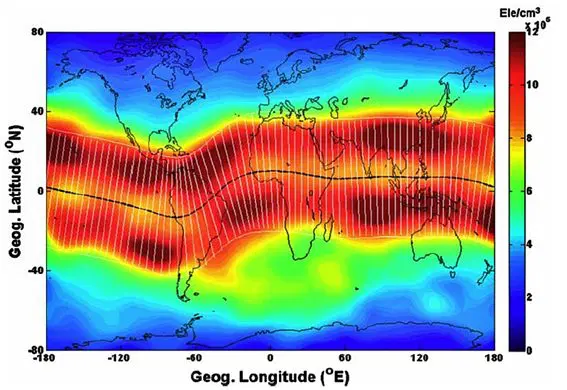High-precision GNSS positioning is vital to a broad range of applications – surveying, mapping, machine control, and autonomous systems, just to name a few – and businesses depend on correction services like HxGN SmartNet to enable these applications with centimetre-level accuracy.
However, no matter how sophisticated the sensor or extensive the reference station network, there are forces at work that can impact the quality of your GNSS signals and positioning.
For example, we are currently in a period of increased ionospheric activity connected to the solar cycle – a phenomenon that has a big impact on high-precision GNSS performance. While the effects cannot be eliminated completely and could persist in varying levels over the next several years, there are some ways you can mitigate impacts for your GNSS positioning applications.
In this blog, experts from the HxGN SmartNet GNSS correction services team deliver a guide to ionospheric activity and GNSS, including causes and some actions to help you continue operating efficiently during increased ionospheric activity.
What is ionospheric activity and why is it increasing?
The ionosphere, a layer of the Earth’s atmosphere ranging from around 50 to 1,000 km high, includes free electrons that affect the transmission of GNSS signals. Significantly for users of GNSS instruments, when ionospheric activity increases, it adversely impacts GNSS signal tracking and positioning performance.
Several factors influence ionospheric activity, including the Earth’s tilt, orbit and rotation, magnetic field interaction and, importantly for this guide, cycles of solar activity.
Higher sunspot numbers, a strong indicator of trends within the 11-year solar cycle, are correlated to increased ionospheric activity. Therefore, a historical and contemporary analysis of sunspots can help us understand the progression of ionospheric activity and predict the temporal behaviour of the current solar cycle.
The chart below shows the solar cycle based on the monthly averaged sunspot number, including measured activity indicated in black and predicted activity in red:

So far, the current solar cycle 25 already shows similar sunspot numbers to solar cycle 24, which peaked in 2015/2016. The predictive takeaway is that we can expect greater adverse effects on GNSS tracking and positioning through 2026, when it will start to diminish.
“You can access information about sunspot activity using resources like the U.S. Space Weather Prediction Center, the EU’s Ionosphere Prediction Service, or spaceweather.com,” advises Christoph Storm, Director of Positioning Services for Hexagon’s Geomatics Division.
“To understand and prepare for periods where your GNSS operations may be affected, we recommend monitoring sunspot activity levels, along with other key factors like solar storms and flares, seasonal variations, and the time of day and location.”
The figure below illustrates the regions of high ionospheric activity on a global map, where the dashed black line represents the geomagnetic equator. Within the region of about 20 degrees north and south of the geomagnetic equator, ionospheric electron density is much higher and has larger spatial variability than outside.

Global distribution of the ionospheric electron density (Source: Inside GNSS, 2021).
In addition, the ionospheric activity changes slowly through a daily cycle. It is usually highest around local noon or a little after and is least between midnight and early morning.
How does ionospheric activity impact high-precision GNSS?
High activity in the ionosphere results in higher total electron content (TEC). GNSS signals travelling through the ionosphere are delayed in proportion to the TEC along the signal path – meaning GNSS signals will experience greater delays where TEC is higher.
In addition to signal delays, localised changes in the ionosphere called scintillations create rapid fluctuations in the amplitude and phase of GNSS signals, causing disruptions to satellite tracking lock and L-Band communications.
While high-precision GNSS sensors can estimate and mitigate for some ionospheric impacts, high ionospheric activity can nonetheless cause many adverse effects on high-precision GNSS. These include:
- Degraded GNSS signal tracking, leading to fewer usable satellites
- Reduced L-Band communication link strength, interrupting reception of precise point positioning (PPP) or real-time kinematic (RTK) bridging data
- Increased RTK initialisation and PPP convergence times
- Decreased positioning accuracy of fixed RTK and converged PPP solutions
“In the most common cases, you may notice a longer time to achieve a centimetre-level solution or degradation in positioning quality, even in open-sky environments.” explains Storm.
With so many variables influencing the amount of ionospheric activity and its impact on GNSS signals, predicting the exact effects for GNSS is extremely difficult. However, there is good news – you can take action to mitigate the adverse ionospheric effects on your high-precision GNSS applications.
What can GNSS users do to mitigate the effects?
Storm and the HxGN SmartNet team recommend the following 7 steps to diminish impacts of increased ionospheric activity on your high-precision GNSS operations:
- Ensure the latest firmware is installed on all your GNSS sensors to achieve the best GNSS tracking and positioning performance.
- Use multiple GNSS constellations, including GPS, GLONASS, Galileo, BeiDou, and QZSS, where available. This will increase the number of observations available to the positioning solution and the diversity of the tracked GNSS signals – more data means higher reliability.
- Utilise multi-frequency (3 or more) GNSS observations and RTK corrections.
- If possible, ensure the default elevation cut-off angle is set to 10°, as ionospheric activity has the largest impact on satellites closest to the horizon.
- When available, use mobile Internet for the reception of PPP/RTK bridging data to provide a backup to the L-Band communication link in case of connection disturbances.
- For high-precision surveying applications, apply double or multiple occupations at different times under different ionospheric conditions.
- Check the latest ionospheric impact in your region using the HxGN SmartNet App or within your local SmartNet Web portal, available for users with a valid HxGN SmartNet subscription. Alternatively, observe and analyse ionospheric scintillation on our free forecast map.
Some GNSS correction services have properties that make it easier to implement these mitigation steps. For example, HxGN SmartNet already has many of these recommendations covered by maintaining the largest reference station worldwide and providing multi-signal, multi-constellation correction data. Additionally, HxGN SmartNet Global enables the possibility to use RTK corrections, PPP and RTK bridging together in one service to help data collection continue despite connection interruptions.
“The unfortunate and unchangeable reality remains that all GNSS and L-Band signals are vulnerable to severe impacts during extreme solar scintillation events. In the worst cases, this means diminished or total loss of GNSS positioning,” says Storm.
“However, by implementing the provided mitigation steps and monitoring ionospheric activity, you give yourself the best chance to maintain the highest level of positioning performance possible in the situation.”
If you have additional questions or would like more information, please reach out to our HxGN SmartNet support team.

Christoph Storm
Director Positioning Services
Geomatics Division














